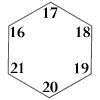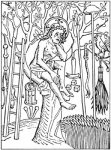

CAMOIN MAGAZINE
by Philippe Camoin
 The card Le Mat has no number; the number of numbered Major Arcana is 21. Twenty-one happens to be divisible only by 3 and 7. Thus from the beginning the Ancients wanted us to pay attention to the numbers 3 and 7 as they were connected with the Sacred world, the world of the Major Arcana. Meanwhile, the world of the Minor Arcana is divided into 4 groups: this is the world of the Quaternary, the world of Four.
The card Le Mat has no number; the number of numbered Major Arcana is 21. Twenty-one happens to be divisible only by 3 and 7. Thus from the beginning the Ancients wanted us to pay attention to the numbers 3 and 7 as they were connected with the Sacred world, the world of the Major Arcana. Meanwhile, the world of the Minor Arcana is divided into 4 groups: this is the world of the Quaternary, the world of Four.
In the Tarot, 56 is the number of Minor Arcana and 21 the number of Major Arcana carrying a roman numeral. The number of combinations possible with three dice is 56 (exactly the number of Minor Arcana). The number of combinations possible with two dice is 21 (exactly the number of numbered Major Arcana). If we add the dots on a single die, we get 1+2+3+4+5+6=21 once again.
On the table of the Juggler, each die shows us three sides: 1+2+4=7. There is no other solution but 1, 2, and 4 to get 7 from three sides of a single die. There are three dice, which gives us 3x7=21.
Finally, if you add each side of a die with the opposite side, you get:
1+6=7
2+5=7
3+4=7
Once again we have 3x7.
Moreover, this series of numbers forms, when placed on a hexagon, a serpent biting its own tail.
1 2 3
6 5 4
1 is the head of the serpent and 6 is its tail. The head eats the tail, meaning that 1 becomes 6. Let us overlap the 1 and the 6 and begin again with the 6 for a new round. We arrive at 11. In doing the same starting with 11, we arrive at 16. In repeating once more, we arrive at 21. We have finished our voyage through the 21 Major Arcana.

|

|

|
We have obtained 1, 6, 11, 16 and 21 as knots in the movement of the serpent Ouroboros. Let us align the corresponding Arcana:

|

|

|

|

|
![]() The Juggler and Strength each have a hat in the form of the infinity sign (the eight on its side). But then, what is the connection with the World, which is at the other end? In fact, 1, 11 et 21 are the two extremities and the center.
The Juggler and Strength each have a hat in the form of the infinity sign (the eight on its side). But then, what is the connection with the World, which is at the other end? In fact, 1, 11 et 21 are the two extremities and the center.
 In The World, there are two infinities. In the card of The World, the two yellow ribbons which tie the light blue mandorla (oval) at the top and the bottom each form a sideways eight of which only part is visible, the other part being hidden by the mandorla. The World contains the two infinities of the Juggler and Strength.
In fact, The Juggler begins the first cycle of ten, from 1 to 10, just as Strength begins the second cycle of ten, from 11 to 20. Each cycle of ten begins with an infinity. This makes 20 cards, leaving one, The World, which is the totality of the two cycles, as shown by the fact that it has the two infinities.
In The World, there are two infinities. In the card of The World, the two yellow ribbons which tie the light blue mandorla (oval) at the top and the bottom each form a sideways eight of which only part is visible, the other part being hidden by the mandorla. The World contains the two infinities of the Juggler and Strength.
In fact, The Juggler begins the first cycle of ten, from 1 to 10, just as Strength begins the second cycle of ten, from 11 to 20. Each cycle of ten begins with an infinity. This makes 20 cards, leaving one, The World, which is the totality of the two cycles, as shown by the fact that it has the two infinities.
Cards 1, 11 and 21 thus suggest to us the symbol of infinity. Let us place the 21 numbers on this infinity symbol which passes through 1, 11 and 21. The two series of 10 are then juxtaposed like in a mirror.
©Copyright Philippe Camoin - 2000

Dice are among the Weapons of Christ or "Arma Christi": objects connected to the death of Christ on the cross. Roman Soldiers are said to have cast dice betting over the tunic of Christ. It is difficult to imagine that these dice in the Bible did not have a high symbolic and numerical value.
It was Fulcanelli, in The Dwellings of the Philosophers, who best depicted the connection between the dice and Alchemy. The etymology of the word "die/dice" comes from a Greek word meaning a die for play, or a cube. Esoterically the die therefore can represent the cube or cut stone, the philosopher’s stone, the cornerstone of the chuch.
A die had to be cast three times on the table, which corresponds to the three dice on the table. Symbolically, these three times will come to represent three different ways on the path—or three different worlds one could say—three initiations, three goals to attain. In alchemy, this is equivalent to dissolving the stone three times, "to obtain it with all its qualities". Nicolas Flamel tells us in this connection that this gives the solution to the hieroglyphic book of Abraham the Jew, composed of three times seven pages. A splendid illuminated manuscript, Fulcanelli tells us, executed at the beginning of the 18th century, contains 21 painted figures, each adapted to the twenty-one operations of the work.
To read the excerpt from Fulcanelli, click here: LE DÉ À JOUER
©Copyright Philippe Camoin - 2000
Philippe Camoin
Logged in visitors: 26